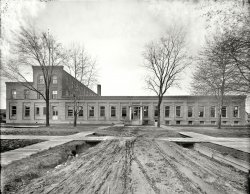
MAY CONTAIN NUTS

Search Shorpy
SHORPY ART

Framed or unframed, desk size to sofa size, printed by us in Arizona and Alabama since 2007. Explore now.
Join and Share
Ad-Free Shorpy
Shorpy is funded by you. Patreon contributors get an ad-free experience.
Learn more.

Recent comments
- Details, Details
- What's that building to the left of the tower?
- Coal Barges
- Bromo-Seltzer
- Inner harbor
- The Basin
- What a headache!
- Giant stepladder?
- Baldwin 62303
- Baldwin VO-1000
- Cold
- No expense spared
- Tough Guys
- Lost in Toyland
- And without gloves
- If I were a blindfolded time traveler
- Smoke Consumer Also Cooks
- Oh that stove!
- Possibly still there?
- What?!?
- $100 Reward
- Freeze Frame
- Texas Flyer wanted
- Just a Year Too Soon
- WWII -- Replacing men with women at the railroad crossing.
- Yes, Icing
- You kids drive me nuts!
- NOT An Easy Job
- I wonder
- Just add window boxes
Member Photos
The Shorpy
Print Emporium
Print Emporium
Search Shorpy
Search results -- 30 results per page
- Moesta's Tavern: 1910
- Detroit circa 1910. "Automobile on Jefferson Avenue at East Grand Boulevard." ... east side saloon." 8x10 inch dry plate glass negative, Detroit Publishing Company. View full size.
Car ID Packard Model 30 ... tavern survived Prohibition but not Mad Men.
Per the Detroit Free Press of May 25, 1936, demolition of the Old Moesta Tavern was ... Posted by Dave - 09/11/2023 - 3:05pm -
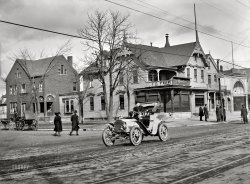
- TRX: 1910
- ... Express reefers at the ready. 8x10 inch glass negative, Detroit Publishing Company. View full size.
Open Air Ship's Wheel ... photo? The source of this great photo is described as Detroit Publishing Co., Library of Congress, but I am unable to find this photo ... Posted by Dave - 09/19/2023 - 3:58pm -
![TRX: 1910 Mobile, Alabama, circa 1910. "Unloading bananas." Tropical Refrigerator Express reefers at the ready. 8x10 inch glass negative, Detroit Publishing Company. View full size.
Open Air Ship's WheelThis is likely an emergency wheel located close to the steering mechanism. The regular-use wheel is forward, in the bridge of this steamship.
BananasThis was about a decade into the long march of the United Fruit Company through Latin America, leaving in its wake "banana republics", untold injustices, and the lasting model for multinational corporations.
Open door policyI'm guessing that the reefers are in "ventilated car" mode, since bananas, while temperature sensitive, don't require the level of cooling some products do (namely frozen ones). The hatches are in the up position to facilitate air flow, rather than for icing.
Where's Harry?I don't see the tally man.
Norway?I can’t make out the name of the boat, and regardless it doesn’t appear that there’s a country listed, but the flag looks Norwegian to me. Does that even make sense?
Mr TallymanThe tallyman and his buddy are on post, they even arranged a bench to check the unloading in comfort.
The banana boat is NorwegianAs evidenced by the flag. It's from Bergen and its name ends in "DØ" The beginning is obscured by the flag
Ship's WheelI don't remember seeing a ship's wheel quite so exposed to the elements outside of a pirate movie.
Sidewheeler IDJas. A. Carney 1894 according to page 219 of the 1910 Annual List of Merchant Vessels of the United Stares
WHAT Bananas?I see coal and not bananas!
"Yes, we have no bananas?"
https://www.youtube.com/watch?v=8QqkrIDeTeA
or if you prefer originals:
https://www.youtube.com/watch?v=PDd8shcLvHI
Where's the Day-O?
Yes, we have no ...I'm banana blind -- not one in sight.
Yes -- bananas!Look carefully at the conveyor just above the righthand white ventilator. The conveyor consists of a series of slings, each one lifting a bunch of bananas.
Hellø BodøHere we see the diminutive 181-foot Norwegian steamer Bodø, launched as the Xenia in 1894 at Bergen by Bergens Mekaniske Versteder for Bergh & Helland of that city. At 666 gross and 398 net tons, it was powered by a triple expansion steam engine supplied by a Scotch boiler. It became the Bodø in 1899 and was chartered to the United Fruit Company to haul fruit, primarily bananas, between Jamaica and the the East Coast. United Fruit chartered many Norwegian vessels around the turn-of-the-last century beginning in 1899. Later named Plentingen, Polar, Samos and Ikaria, it was dismantled in Greece in late 1928. It has appeared before on Shorpy (as has a similar comment of mine!)
Gaillard-Johnson Coal CompanyFrom the 1909 Mobile city directory. When cities had more than one telephone company. Coalyard located at foot of St. Anthony. Phone Bell 248 or Home 51.
[City directories go back to before people even had telephones. - Dave]
Walking the GangplankAs a free-range kid in Mobile, I have personally watched bananas being unloaded from a ship, circa 1950. It was nothing like this photo. There was a slanting gangplank between the ship and the dock, and a continuous line of men descending with stalks of bananas over their shoulders. I recall the gangplank being wooden, but am not sure of this.
Nor do I recall how the men got back on board, but obviously they did.
“Lighter”I’m interested in the boat off to the right of the ship. It’s actually a barge called a Lighter. These were, and in some cases still are, used to service ships in port. In this case the Lighter is providing coal to fuel the steam boilers. It has never been clear to me where the term came from. Some have suggested it’s from the German “Lichter” as some barges were used to off load (lighten) small deliveries to shore from large ships.
Another great photo.
Source of photo?The source of this great photo is described as Detroit Publishing Co., Library of Congress, but I am unable to find this photo at the Library of Congress website. Could someone provide me with a link to the photo? I've tried every search term I can think of.
[This was one of a group of hundreds of damaged glass negatives added to the LOC archive in February. They have yet to be captioned, so will not show up in search results. - Dave]
(The Gallery, Boats & Bridges, DPC, Mobile, Railroads)](https://www.shorpy.com/files/images/SHORPY-4a55225a.thumbnail.jpg)
- Product Launch: 1905
- Circa 1905. "Launching of the Detroit (Detroit Yacht Club)." 8x10 inch glass negative by Lycurgus S. Glover, Detroit Publishing Co. View full size.
A Champion In August of 1905 ... Posted by Dave - 12/05/2014 - 12:12pm -
![Product Launch: 1905 Circa 1905. "Launching of the Detroit (Detroit Yacht Club)." 8x10 inch glass negative by Lycurgus S. Glover, Detroit Publishing Co. View full size.
A ChampionIn August of 1905 the yacht Detroit won the Lipton Cup in San Diego.
[Steeped in history! - Dave]
This Detroit boat looks so modernJust I wanted to write. Very modern boat as almost 110 years old. Very streamlined.
Happy DaysQ: What are the two happiest days of a sailing man's life?
A: The day he buys his own boat and the day he sells it.
The precise date of this photograph isJune 4, 1901, and shows the launching of the Detroit at the yard of the Michigan Yacht & Power Company, situated just south of Jefferson Avenue on the Detroit River just east of downtown. The boat had been commissioned by a Detroit syndicate headed by Alex McLeod, shipowner, former newspaper editor, founder of the Detroit Telephone Company, and Commodore of the Detroit Yacht Club. The vessel was intended to compete for the Canada's Cup races at Chicago, but failed to qualify, losing to another Detroit boat, the Cadillac. It was sold in Spring 1904 to a San Diego syndicate, sent west by rail, underwent some modifications, and, as already indicated here, quickly became one of the premier racing yachts on the Pacific coast, but for only a brief time, as her design and ownership raised questions among Southern California's racing elite and she was banished from racing by 1906.
(The Gallery, Boats & Bridges, Detroit Photos, DPC)](https://www.shorpy.com/files/images/SHORPY-4a14844a.thumbnail.jpg)
- Bustling Detroit: 1912
- The Motor City circa 1912. "Campus Martius. Detroit City Hall, Bagley Fountain and Majestic Building." Detroit Publishing glass negative. View full size.
Testamentary ? ... Posted by Dave - 03/29/2017 - 2:57pm -
![Bustling Detroit: 1912 The Motor City circa 1912. "Campus Martius. Detroit City Hall, Bagley Fountain and Majestic Building." Detroit Publishing glass negative. View full size.
Testamentary ?/-'men-/ a. of or given in a person's will.
Yes, I had to look it up in the Oxford dictionary.
Zip!I'm always a little impressed with how quickly modern America happened: stone-built cities rivalling Europe's, built up from bare ground in little more than a lifetime and packed with cars recognisably like our own only eight years after Oldsmobile introduced mass-produced cars.
And some of the people in this scene may have flown around the World on jet airliners.
Always a surprise... to see how much the automobile changed both our lives, and the views of the city streets that these photos provide. When is the last time that Detroit saw horse-drawn deliveries? There are still enough horse-drawn carts for deliveries and vendors to make their appearance in 1933's "Duck Soup" seem plausible. Did Detroit, the city built on the automobile, get rid of their old-fashioned alternative sooner?
Car-mounted catcherI just came across this picture last night, of this cow catcher touted for autos.
https://www.shorpy.com/node/4468
This picture, on the rightThis picture, on the right hand side, looks the opposite direction down Woodward Ave than the Eureka 1910 picture does. I'm surprised mostly by how many streetcars are running up and down Woodward. Not just one every hour or half hour, but dozens in a one block area.
Watch your step!Look at the drop from the front of that streetcar step to the pavement, yikes! Don't know how women managed with those long cumbersome dresses. It's good the miniskirt came along - strictly for the comfort of the ladies of course, naturally.
Bagley FountainThe water fountain in the foreground was given to the citizens of Detroit by John Bagley; one of the founders of the Republican Party, staunch Abolitionist, City Councilman, Governor of Michigan and tobacconist.
Long before Detroit was the center of Automobile manufacturing, tobacco was a huge business with over 100 cigar and snuff factories in different parts of the city.
The Bagley Fountain was built for both humans and horses as I believe there is a horse trough on the side we can't see. It was moved to Cadillac Square in the 1920s (I believe). It is still there and was outfitted with new piping a couple years ago.
I can't say I've ever drunk from the fountain as it is mainly used by our wandering class of citizens for their morning ablutions. Personally I care to honor their territorial markings.
For more complete information, may I suggest:
http://historicdetroit.org/building/bagley-memorial-fountain/
HorsedrawnWhen I was a child, in the early '50's, they were still delivering milk with horses, at least in Flint, "The Auto City".
Hanging OnYes, you, the guy standing in the window in the Majestic Building.
Watch Out For The Cows!tterrace's comment had me going to Google to see what these contraptions were called when fitted to streetcars. Apparently the proper terminology was "streetcar fender". There were an abundance of patents issued for designs to enhance the safety of pedestrians who were reckless enough to walk in front of moving streetcars. Some required the conductor to pull a cord to lower the fender when a collision was eminent, while others were designed to be deployed full time on the forward facing end of the streetcar.
Streetcar catcher contraption?Looks like the the thing on the front of the streetcar was designed to provide a humane landing zone rather than just plowing cows/horses out of the way.
[That's a cowcatcher. - tterrace]
Gone, gone, goneCan you imagine that when the Old City Hall was demolished in the 1960s, they considered it progress?
(The Gallery, Cars, Trucks, Buses, Detroit Photos, DPC, Streetcars)](https://www.shorpy.com/files/images/SHORPY_4a25138a.thumbnail.jpg)
- Welcome to Detroit: 1900
- Detroit, Michigan, circa 1900. "City Hall and Campus Martius." To the left, the ... note. 8x10 inch glass negative by Lycurgus S. Glover, Detroit Publishing Co. View full size.
American Idyll I think any ...
In 1894 Austin TX bought a bunch of the towers from Detroit and moved them southwards. Through a fluke of history, half of them ... Posted by Dave - 08/13/2013 - 3:50pm -
![Welcome to Detroit: 1900 Detroit, Michigan, circa 1900. "City Hall and Campus Martius." To the left, the Soldiers and Sailors Monument; rising to the right is one of the city's "moonlight tower" carbon-arc lamps. Palm trees and bananas strike a tropical note. 8x10 inch glass negative by Lycurgus S. Glover, Detroit Publishing Co. View full size.
American IdyllI think any city would be glad to have such a civic building. Interesting French (Second Empire?) style architecture.
I love the two men languidly conversing on their bicycles, oblivious of the surrounding traffic. Try that today! In toto the pedestrians look like a idealized Hollywood scene representing city life at the turn of the 20th century; people running, promenading, talking, pricing fruit perhaps on a fine summer's Sunday.
Moonlight Towers: now Austin residentsThose carbon-arc lamps were once very common ways to light a city, much more economical than a lower-wattage streetlight every 100 feet. The light they gave off was by all accounts glaring and harsh, though.
In 1894 Austin TX bought a bunch of the towers from Detroit and moved them southwards. Through a fluke of history, half of them survive to the present day, making them the only remaining functional towers in the world. One played an important cameo in "Dazed and Confused." All the remaining towers (17 of the original 31) are protected historic monuments, though two were recently removed. Austinites, myself included, are strangely fond of them.
The rest of the story: http://en.wikipedia.org/wiki/Moonlight_tower
Idyll Over"I think any city would be glad to have such a civic building. Interesting French (Second Empire?) style architecture."
You might think that, but Detroit tore this building down in 1961. It was seen locally as embarrassingly old-fashioned soon after the turn of the 20th century.
The editor of the Detroit News described it thus: "It is an architectural monstrosity. It belongs back in the twilight zone of American development. … It belongs to the era of the whatnot and the putty vase and the ship carved in a bottle. It is not Colonial, it is not Gothic, it is not Byzantine. It just ain’t nuthin’. It’s been standing there these 70 years or more, a lumpy, gloomy, ugly pile of curlicued stone. No artist has ever painted a picture of it. No artist would. No lover of beauty has ever found a single line of grace or dignity in it."
And not a car in sight. I think this photograph shows the destruction wrought on the American landscape, and social fabric, especially in urban settings, by the advent of the automobile a short time later.
The Motor City!Where are the cars?
(Always interesting to me how long it took for automobiles to take hold.)
Moonlight Bat BuffetLiving in Austin in the 80's I used to frequent a cafe in the Clarksville section of town where I would often see some of Austin's famous Mexican free-tailed bats feasting on the insects drawn to glow of moonlight towers. Austin, whose unofficial motto is "Keep Austin Weird," is a Mecca for bats, batty moonlight tower protectors, and all things odd and different. I'm glad to hear from Kevin M. that the towers are still there.
All those people are deadbut yet, when I put this on full screen, I still get the feeling I could just step into the scene and walk or ride my bike amongst them. I love these pedestrian/scenic pictures. Sure glad somebody invented the camera when they did.
CinematicThis does look like a Hollywood scene! Now we have our cars, our phones, our iPods, etc., and you would never see people out strolling about and chatting like this! We (myself included) are always in our cars and in a hurry!
Wayne County BuildingOne of the previous commentators mentioned that this building was torn down. It is actually still standing.
[You're confusing City Hall with the Wayne County Building. City hall is long gone. - Dave]
(The Gallery, Bicycles, Detroit Photos, DPC, Streetcars)](https://www.shorpy.com/files/images/4a18953a.thumbnail.jpg)
- Office Cubicle: 1911
- ... and Ontario Street." 8x10 inch dry plate glass negative, Detroit Publishing Company. View full size.
The whole building? B of ... Posted by Dave - 11/13/2023 - 2:36pm -
![Office Cubicle: 1911 Cleveland, Ohio, circa 1911. "Brotherhood of Locomotive Engineers Bldg., St. Clair Avenue and Ontario Street." 8x10 inch dry plate glass negative, Detroit Publishing Company. View full size.
The whole building?B of LE Building ... does that mean the brotherhood used the whole building?
[They owned the whole building. - Dave]
Full frontalSo we get the glamour shot of what we only had a tantalizing glimpse of a half-year ago. Still around, and still durned impressive ... or incredibly monotonous, depending on your preferences.
[Er, no. That "tantalizing glimpse" was of a different building. - Dave]
We can take comfort in being wrong together: you're pointing to the building across the street - which wasn't built until a decade after this picture, and I was mistaken that this is extant ... sadly
StaredownIs that a Studebaker electric facing off with that horse?
No Safety BarriersThe unfinished streetcar tracks catch my eye and how it is not surrounded by any sort of safety barriers - another reminder of how it was a different time back then. Also, wonder what the BoLE Auditorium looked like. Probably not as ornate as what would be created in another 10-15 years.
Safety lastA torn up street and no barricades or traffic cones. Must have been before personal injury lawsuits were invented.
At home in ChicagoThis style is from the Chicago School of architecture, which emphasizes the building's structural grid, uses relatively little ornamentation, and has large plate-glass window areas. I think it's a good look, especially considering that buildings would eventually be clad in only glass curtain walls.
(The Gallery, Cars, Trucks, Buses, Cleveland, DPC, Railroads, Streetcars)](https://www.shorpy.com/files/images/SHORPY-4a24063a.thumbnail.jpg)
- Old Ferry Lane: 1910
- ... Kittery Point, Maine." 8x10 inch dry plate glass negative, Detroit Publishing Company. View full size.
Kittery in railroad lore ... Posted by Dave - 10/21/2023 - 4:51pm -
![Old Ferry Lane: 1910 Circa 1910. "Old Ferry Lane -- Kittery Point, Maine." 8x10 inch dry plate glass negative, Detroit Publishing Company. View full size.
Kittery in railroad loreRailroad fans know of Kittery because it is home to the least active rail line in the country. The line goes to the Portsmouth Naval Shipyard and averages two trains, of just a few cars each, per year. Rumor has it that they carry radioactive waste from submarines to disposal sites in Idaho, but the Navy won't say.
A Nice WalkFound the spot the photo was taken! Looks like the house is still there as of 2017.
Just love this old photo, makes me want to walk down that dirt road on a nice summer day with my dog.
Kittery Shipyard rail moveThey did a move to the yard back in September. Here is a video from a rail move last year:
There's a signpost up aheadWe see the small sign, Old Ferry Lane, at right. But, past the branches, there is another sign for those headed in this direction. It's a much longer sign. I wonder what it says?
["I'M ACTUALLY A FENCE"? - Dave]
This could be the house.
The trail of evidence suggests ...This view seems to be close to the spot in the original image.
The stone wall in the original has been lowered and smoothed over in the current view. But the mall cape in the distance has the same dormers looking out over the roofline, and the outcrop of stones along the edge of the driveway today is also present in the original image.
Sure does seem like the spot. I've commented earlier that "things don't change much in New England." Even more of a truism in coastal Maine.
Bicycle tracks?It looks like there are more bike tire tracks on that road than anything else.
[Um, those are wagon tracks. - Dave]
The Box on the Pole:What is the box used for? Just local messages to people in the neighborhood?
Box on the pole:Judging by the porcelain knob and electrical wires running to the box, my guess is there's a switch in the box to turn on a light at the top of the pole.
That box is wiredIn addition to being padlocked, the box on the pole has two wire connected to it. One passing around a ceramic insulator and then goes up the pole passing yet another insulator. Another goes straight down to the ground from the bottom of the box. I'd guess this means it's its power and the box may be a junction box or fuse box.
Re: Box on poleThat appears to be a single wire telephone. The wire coming down the pole goes into the phone while the wire at the bottom completes the circuit using earth return. OK for short hauls but the noise level increases rapidly with distance. Probably a dedicated service customer protected with padlock.
The WallInstead of the stone wall having been shortened, I'd think the more likely scenario is that the level of the road has been graded and raised, obscuring the lower portion of that cement capped stone wall. Great photos.
(The Gallery, DPC, Landscapes)](https://www.shorpy.com/files/images/SHORPY-4a23484a.thumbnail.jpg)
- Miller Time: 1942
- September 1942. "Detroit, Michigan. Milling machine operator at the Allison Motors plant." ... port right of center.
(The Gallery, Arthur Rothstein, Detroit Photos, Factories) ... Posted by Dave - 10/15/2023 - 5:06pm -
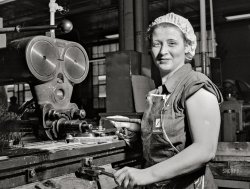
- Vacation Wagon: 1964
- ... In 1951 our family, my wife, son and daughter, living in Detroit, started taking trips to Cheney, Washington, to visit my WW2 buddy. All ... Posted by Dave - 05/31/2022 - 1:09am -
![Vacation Wagon: 1964 Our annual salute to the start of vacation road-trip season, first posted here 15 years ago. Everyone buckled in? Let's go!
"Great Falls, Montana. Return after 3 weeks Vacation. June 27, 1964." This Kodachrome of a 1960 Chevrolet Parkwood station wagon is from a box of slides found on eBay. View full size.
family trips in those carsI also spent some hot days in a car like that on the way to the grandparents. My mother flattened the second seat, put a mattress on the floor and loaded three of us and the stuff in on top of it, us and the stuff equally loose and not tied down. We whined and fought and slept our way to Cape Cod from southern NJ. My father always "had to work" (they were her parents), so she did the drive alone, I think maybe 12 or 16 hours? Seemed like forever.
NostalgicThese people still had a bright future ahead of them, full of great hopes for the days to come. They hadn't gone to the Moon yet, and to them, by 2007 we'd have personal helicopters and robots would run everything. The possibility of the President being indicted for a crime was unthinkable. My job as a web designer hadn't even been invented yet.
The lawn looks like it's literally astroturf. Were the colors really like that, or is it an effect of the kodachrome?
Holy cow! We had a 59 chevyHoly cow! We had a 59 chevy stationwagon back in the day. Does this bring back memories. We would drive to Florida from Virginia a two day trip usually in the heat of the summer to visit grandparents. Five children two parents no ac. Damn!
[This is a 1960 Chevrolet. - Dave]
DeflectorsDoes anybody know/remember what the deflectors left and right of the rear window were for? These may have been an aftermarket item.
It is amazing how well the colors in this slide are preserved after almost 50 years. It looks like Kodachrome all right, including the telltale blue cast in the shadows
The Astroturf look......to my eye, seems to come from the little flowers (or toadstools?) that are in the lawn. At the smaller image size, they look like specular reflections, making it seem like the grass is shiny.
[The white flowers are clover. - Dave]
1964As I remember it, this was less than a year after the assassination of JFK, there were race riots in the south and we (I was 14) were all starting to question attitudes towards women, blacks, hispanics, homosexuals and the culture we had grown up with. One of the more minor cultural things was the importance of your front lawn.
50 years?I was born in 1964, and trust me, it hasn't been 50 years since then, yet.... ;)
Re:DeflectorsThe deflectors on either side of the rear window were intended to blow air across the rear window to prevent snow from accumulating. A similar deflector is often fitted along the roof on station wagons from the 60s on. I think they were usually a factory or dealer option in later years, but I really don't know specifically about this model or when they might have first been used.
OK, 40 years.Sorry, I was too vexed on the year of manufacture of the car.
I remember that someone in our street had the sedan version of this Chevy. Like any 8 year old, I was fascinated by the winged tail and the panorama windshield. You didn't see many of these in Europe around 1960; everbody, including my father, was driving Volkswagen Beetles. (He later had a new Ford Mustang 1964 1/2 , with a 289 ci V8 and a four speed box, rally pack and (optional) front discs, which I found very impressive at the time. A real gas guzzler by European standards.
Family TrucksterThis is probably what Clark Griswold's dad took the family on vacation in. It's a 1960 Chevy, and I'm guessing it's a Kingswood model. The Brookwood was the more stripped down model and I think the "full dresser" was called a Nomad. This one isn't completely chromed-out and it has the small, dog-dish hubcaps so I'm thinking it's the middle of the line model.
I think the rear air deflectors also helped keep exhaust gas from entering the rear passenger compartment when the vehicle was moving with the tailgate window was lowered. Though it doesn't look like there's room for anybody in the third row of seats for this trip. With the window up they also helped keep the rear glass clear of snow and dust.
These are Parents of the Year......in my book. Can you imagine going across country now without all of the luxuries and Wendy's and portable DVD players and Nintendo and cell phones and credit cards?
These parents did it all the HARD way...and I'll bet they made a lot of memories that summer!
My jaw droppedOnce again the red stationwagon family blows me away. The color composition here is perfect.
Chevy ParkwoodThis is a 1960 Chevrolet Parkwood. Parkwoods and Kingswoods both use Bel Air trim (mid-level). The Kingswood, a nine-passenger wagon, has the third-row rear-facing seat, and two steps on the rear bumper (one on each end just outside of where the tailgate would come down). Less obvious is that all Kingswoods have power tailgate windows, an option on the other Chevrolet wagons.
I still drive a '59 ChevyI recommend owning one. In 2000 We took the ultimate road trip with mine from near the Canadian border in Washington State through the desert to Las Vegas and back up through California and Oregon. There really is nothing like seeing the U.S.A. in your Chevrolet. Cruising the Strip in Vegas was a blast. We might as well have been driving a space ship with the reactions we got. Sadly, these Chevrolets were mostly scrapped and very few survive.
60 ChevySadly, the third row seat had not been invented as of yet and the deflectors were used to deflect air into the rear of the stationwagon at slower speeds. I may not be an expert but I'm old enough to have ridden and slept in the back section of a folded down stationwagon. We didn't know about SUV's yet.
Chevy WagonChevy's Parkwood and Kingswood wagons could both be had with a third-row seat. And back then, for the record - wagons WERE the "SUVs" of the day!
[According to the 1960 Chevrolet sales brochure, only the Kingswood was available with third-row seating. The International Travelall and Chevy Suburban Carryall were two of the SUVs of the day. - Dave]
The luggage rackis something you don't see anymore. It hung on the wall of the garage when not in use. Once my dad, who was in a big hurry, didn't secure the tarp on top properly...
We played car games, like Alphabet, Road Bingo, and License Plates, read books, colored,sang songs and squabbled. You took your chances with local restaurants. We hadn't got used to entertainment on demand, so we didn't miss it.
And to Dave Faris: It's the film. I once assured my daughter that colors when I was a kid were the same as today. "The Fifties," she said, in her narrator's voice, "were an oddly-hued decade."
Slide ConversionHow does one convert slides to digital photos? Any website links or advice?
[You'd use a film scanner. I used a Nikon 4000 ED for this one. - Dave]
Family TrucksterWe had a green Ford station wagon, not nearly as nice as this, and with our family of six, it was a masochistic experience to take family vacations. Every summer we said that's it, we will never do this again, until the following summer when we did it again. The best part was arriving home again, but I will say that NOT having DVD's and high tech electronic gadgets forced the kids to look out the window and they gained incredible geographic knowledge from seeing the U.S. I could truthfully call these annual trips "purgatory on wheels."
Road TripMost all of my long-distance car trips were connected with moving as my father was in the USAF. In August 1954, after being in the UK 2½ years, we got in our in our '53 Chevy coupe and went from New York City to the SF Bay Area, mostly along US 40. Entertainment consisted of looking at the scenery and checking off the towns on the free roadmaps that the service stations provided in each state. Iy being the pre-Interstate era, one did go thru many towns back then! (Excepting on the PA Turnpike) Burma-Shave signs relieved the boredom in the rural areas. We had a car radio (AM only, of course), but for some reason I can only recall it being used while crossing the salt flats west of Salt Lake City.
Westward HoIn 1951 our family, my wife, son and daughter, living in Detroit, started taking trips to Cheney, Washington, to visit my WW2 buddy. All on old state highways, no air conditioner, 4½ hours to get through Chicago and the kids loved it. Took these trips out west to the 1970s. We still go west to see my buddy and my daughter in Seattle and we enjoy crossing Nebraska on old U.S. 30. It is a treat to be off of I-80.
Nostalgia Ain't What it Used to BeDon't look at this picture and pine for the old days.
Change the car to a green Olds Vista Cruiser and that's us in 1969. Back then, dads bought a new station wagon to kick off the summer vacation. Dads don't buy an SUV today for that reason.
Without repeating some of the horrors already mentioned below, there was the additional joy of Mom sending back a Coca Cola bottle for one of her sons to use in lieu of a loo. If the girls had to go, we had to pull over. Not so with the boys.
Watching mom backhand-fling a Coke bottle out her window, filled with fluid far different that what was originally intended, and seeing it bounce and spill along the shoulder as we whizzed along at 75 mph (pun intended), that's about the fondest vacation memory at least from the car perspective.
Today with the daughter hooked up to a video iPod and the sons enjoying their PSP, it's a pleasure to drive for distances. Back then, we didn't play License Plates. We played Punch Buggy and Slug Bug, etc. Fistfight games.
Let's go!I loved car trips, and I never had DVD players and Nintendo. I watched the scenery and kept a travel diary. those were some of the greatest times of my life.
Road TrripWe had to make do with pillows & blankets. A mattress would have made it actually comfortable. I don't know if Dad didn't have the imagination for that, or just not the money. I suspect the latter.
We'd sing sometimes. It was 12 hours from north Georgia near the North Carolina line to south Georgia, near the Florida line, where my grandmother lived.
I see the moon; the moon sees me.
The moon sees the one that I want to see ...
Thanks for the memoriesMy folks had the four-door sedan version of this car, in sky blue & white. My mom used to have a station wagon, don't remember what kind, but it was memorable for its pushbutton transmission on the dash instead of a gearshift! However my favorite "finned" car was our family's Buick Invicta. Now that was a car!
Third Row SeatsFords had third-row seats in 1955. I'm pretty sure Chevy had them by 1958 at least. Chevy didn't offer woodgrain sides until '65.
Sunday ridesWe had that same car, only in light blue.
No seat belts or infant seats for us! We'd put my baby sister in one of those deathtrap baby seats that hooked over the front seat and off we went!
What a picture!This picture takes me back almost 40 years to the road trips our family did during summer holidays when I was a little boy. It feels like I myself am stretching my legs after coming home. The colours, the moment -- one of my favorite pictures in Shorpy.
My Favorite Car was a 1960 Chevrolet Impala 2-dr hardtop. Bluish gray with white segment on the side, red and white interior. The first car my wife and I bought. Paid $1750 for it used in 1962. We made some wonderful trips in that car.
Re: Family TrucksterJust saw this item on TV yesterday about a real family named Griswold that had their station wagon modded to look like the Family Truckster from National Lampoon's Vacation movie for their trip to Disney World.
http://tinyurl.com/plo5kub
See the USA in Your ChevroletFor our family, it was a 1962 Buick Invicta wagon. Huge car designed for doing massive mileage on the interstates and that's what we did -- six or seven hundred miles a day from Indiana to the Rockies for our annual vacation.
Procedure for Accessing the Cargo AreaWe had one of these when I was a kid as well. Ours was a silver gray color. See the chrome disk on the trunk door? Upon arriving at destination, here's what you had to do:
1) Put trunk key in center slot (separate keys for ignition and trunk back then)
2) Open flap (as seen in photo)
3) Rotate flap several times till rear window is fully down
4) Reach in and grab handle to drop tailgate
Simple, huh?
Looking at old red carsmakes my elbows hurt! Seemed like some of those old single stage paints, reds in particular, had to be waxed every two weeks to keep them looking decent. The widespread adoption of clearcoat finishes in the late 80's to mid 90's freed modern kids from the dreaded frequent waxing chore, thereby giving them the leisure time to start the video gaming revolution...
As Long AsThis isn't really the "End of the Road"! That's a scary title for all the Shorpy Faithful.
3 Adults + 7 Children =1000 mile round trip to see grandma.
We kids didn't mind a bit.
Seat belts?I don't think you heard "Everybody all buckled up?" all that much in '64. I'm not sure of the exact dates, but if you had seatbelts back then, you bought them at a discount store or an auto parts store like Western Auto or J. C. Whitney, and they were lap belts only. Three point seat belts didn't come along for several more years, if I recall correctly, and it wasn't until the government mandated new cars with ignition interlocks in the 1970's that "real men" started to actually use them.
Back then, we used to spend our vacations camping, so the car was packed to the gills, including the center of the back seat. My sister and I each got little cubbyholes next to the doors, with just room enough to sit for the trip to northern Wisconsin. My dad drove a two tone green '55 Oldsmobile Delta 88. I saw a picture of that car a few months ago, and as soon as I did, I started remembering a surprising amount of detail about the car's details. It was handed down to me when I went off to college in '64.
Seat beltsbobdog19006 is correct in that seat belts were not standard equipment in 1960. However, they had been available as a dealer-installed option since the 50s. By 1966, they were standard in all Chevys, and by 1968, they were federally mandated.
I spent many a happy hour on family roadtrips in our '68 Ford wagon, nestled in the narrow gap between the second row and the rear-facing third-row seat, no seat belt, of course. Neither did my siblings in the third row.
Service StickersI remember those stickers that service stations or car dealers put on the inside edge of the driver's door when you got your car serviced. This Chevrolet has two.
Our road trip rigWe had a '76 Chevy Beauville van, a ho-hum light brown rather than red, which made up for the lack of chrome spears with its cavernous interior: two bucket seats in front for Mom and Dad, two bench seats, and a homemade plywood bed. Strangely, all that space wasn't enough to prevent sibling quarrels.
The best story of this van was the return trip of its maiden voyage, when my uncle, who owned a small niche-market manufacturing firm, talked my dad into towing a piece of equipment from South Texas to a parking lot near Chicago, where we would deliver it to his customer from Wisconsin. We quickly got used to being asked at every single hotel, gas station, and rest stop, exactly what was the three-wheeled contraption with the hydraulically-actuated vertical roller-chain conveyor with teeth.
The looks on everyone's faces when my dad told them it was a grave-digging machine: Priceless!
Curtains?Every August for years we travelled from Birmingham to Cincinnati for a week of visiting my parents' relatives. Before our last such trip in '69, we went through a black-and-white '57 Plymouth Savoy, a metallic-beige '63 Ford Country Sedan wagon (the one without wood on the sides) and a '67 Olds VistaCruiser. I'd love to have that VistaCruiser back today. Ours was burgundy red and my dad put red stripe Tiger Paw tires on it. Imagine a 442 station wagon.
As for Shorpy's '60 Chevy wagon, I only just noticed the homemade or aftermarket side curtains, with vertical stripes of brown, gold and red to compliment the bright red car.
Thanks, Dave, for showing us this photo again... and including all the original comments, too. Great to relive all the great summer vacation stories with everyone!
Re: deflectorsIn the days before the rear window wiper on a station wagon, some folks put these on and the deflected air current would help to clean off that window to a degree. Not having either, within a mile that rear hatch would be almost impossible to see through. Been there, done that and got the tee-shirt.
This does bring back memoriesWe had a similar station wagon, but it was salmon (or was it mauve, or ecru?) colored with a white top (I think). It had a 460 a/c (four windows down while traveling sixty miles per hour, some times 560 with the rear tailgate window down). I remember taking a trip from Mississippi to Six Flags over Texas on U.S. Highway 82 (two lane most of the way) in Summer, 1964. The back seats were folded down, and the four of us kids had pillows, blankets, books, and board games to pass the time. It was replaced soon after with a 1965 Ford Country Squire Wagon with a/c, and fake wood paneling on the side. Instead of a rear facing bench seat, it had two small seats on either side that faced each each other.
Memories of summer tripsWe also lived in Montana back then, and our family truckster in the 1960s was a 1963 Rambler Classic station wagon. (Yes, I suffered greatly for it among my friends.) That's what I learned to drive, and we ranged all over the western US and Canada in it.
Before that, however, we traveled in a 1949 Studebaker Land Cruiser 4-door sedan, which my dad (both inventive and frugal) had outfitted with a set of three back seats that, when covered with the mattress from our roll-away bed, filled the back seat and trunk area with a very passable sleeping unit. That's where I spent most of my time on our travels. At other times, I would climb over the front seatback into the front bench seat between my parents. That's where I was on August 5, 1962, when we were preparing to leave Crescent City, CA, and heard on the radio that Marilyn Monroe had died.
Deflector's actual purposeWas to break the "vacuum" the "wall" that was the rear of that wagon created which would suck exhaust into the car if that rear window was open even a little bit. The fresh air, the snowless/cleaner rear window were merely bonuses...
Buckle up?A 1960 Chevy wagon probably didn't have seat belts unless the owner installed them. The kids in the back were pretty much free range as long as they didn't make too much noise. Lots of people piled the stuff on the roof and put a mattress in the back for the kids.
It was a great way to go and most of us survived.
[Seat belts were optional on all 1960 Chevrolets. - Dave]
Car playgroundMy folks had a Ford wagon of that era. No seatbelts. Folks put a mattress in the back. Became our playground on long trips. We had no desire to "sit" in a seat.
Miss station wagonsI miss station wagons. I prefer them to the SUVs that replaced them.
I also miss the bold bright colors that cars use to come in.
No SquattingLooking at all the stuff already loaded, I'm surprised the back of this wagon isn't dragging on the ground. In fact it's sitting pretty level. I wonder if dad had overload springs installed?
We've had one built for you.To BillyB: Station wagon suspensions were designed with the idea that they would have to haul some combination of eight people and their luggage, so they did OK when loaded down. They *were* softer than contemporary pickup trucks, so the back end of the station wagon wouldn't bounce all over if there were only one or two people in it. Especially at the time of this photo, gas was 25 cents a gallon and would be that price forever, so the factory didn't mind spending a little extra weight on a beefier suspension.
Also, most of the really heavy luggage went on the roof rack, which was fairly close to being in the middle of the wheelbase. The back-back, behind the rear seat, tended to contain lighter things, like blankets, pillows, the picnic basket, and - as the trip progressed - bags of souvenirs. If Dad wanted to use the inside rear-view mirror, you couldn't stack stuff much higher than the seats, anyway.
Source: I rode in the back of a '79 Oldsmobile wagon every summer from '79 to '87. I think the longest trip we took in it was from Kansas City to Washington, DC and back.
WagonsWe had a 1956 Ford wagon, then '61 Mercury wagon, finally a (I think) 1964 Ford wagon.
I remember one year with the Mercury, my mom ran low on gas. We were up in the mountains in a resort town. To get to the gas station, she had to reverse up hills, turn around for the downhills, turn around again for going up the next hill. What a ride.
Another time, 1965, we were in a typhoon in the current wagon. There were eleven of us in it. Another wild ride driving on a road along the bay. Waves washing over us, my mom hugging the middle of the road (there was an island we could not get across).
Wagons were great.
The 283 V-8with its 170 gross horsepower is not going to have much highway passing reserve with all that weight. Cross-flags over the V on the tailgate would have indicated one of several 348's which would have given more than enough reserve. That car is 58 years old but properly equipped could have kept pace with most cars on the road today in equal comfort. A 58 year old car in 1960 by comparison was barely even recognizable as such it was so rudimentary by comparison to the 1960 version in its looks and capabilities. The same comparisons held true in all other realms of life comparing 1960 to 1902--homes, conveniences, dress, you name it. Virtually any of those later areas are not that significantly different from their 1960 versions.
Those deflectors... were supposed to keep dust off the back window
Nikon CoolscanI am having a problem with mine. Can you recommend a place that can repair them.
[There aren't any. Try buying them used on eBay. - Dave]
283 V8Although I agree that a 348 engine would have been a better choice for this station wagon. The 170hp 283 was the base V8 engine with just a single two barrel carburetor. The next option up was also a 283 but with a four barrel which the above wagon may have had, which would have given it a little more passing power.
Koolscan softwareDave. What software program do you use with your 4000? As it seems the program that came with it is only works for Microsoft VISTA.
[I use the NikonScan software that came with the scanner, on a Windows 10 workstation. To install the software on a modern operating system, you have to disable Driver Signature Enforcement. And it's Coolscan, with a C. - Dave]
(The Gallery, Cars, Trucks, Buses, Kodachromes 1, Travel & Vacation)](https://www.shorpy.com/files/images/vacation_1960s_00.thumbnail.jpg)
- Cleveland: 1912
- ... House, Public Square." 8x10 inch dry plate glass negative, Detroit Publishing Company. View full size.
Jaywalkers I love these ... Posted by Dave - 11/12/2023 - 12:37pm -
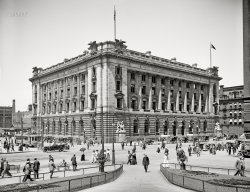
- Sootyscape: 1918
- Detroit circa 1918. "Sky scrapers from interurban station, Jefferson Avenue at ... Fords , not the Model T Fords), Dime Savings Bank , Detroit City Hall , Hotel Pontchartrain and Real Estate Exchange . 8x10 ... Posted by Dave - 11/09/2023 - 2:27pm -
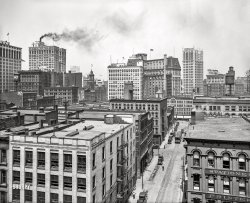
- Detroit Rubber Works: 1908
- The Detroit River circa 1908. "Morgan & Wright Rubber Works." The enterprise ... glimpsed here . 8x10 inch dry plate glass negative, Detroit Publishing Company. View full size.
From Bicycles to ... from bicycle tires to auto tires, and Chicago to the Detroit, was the way to go. Thus, around the time of this photo, Morgan & ... Posted by Dave - 09/04/2021 - 10:41am -
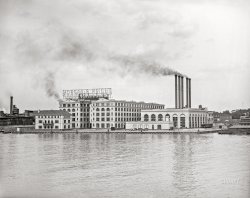
- Size Matters: 1942
- September 1942. "Detroit, Michigan. Learner at the Allison Motors plant. Dimensional finishing." ... age than today.
(The Gallery, Arthur Rothstein, Detroit Photos, Factories, WW2) ... Posted by Dave - 10/14/2023 - 11:17am -
![Size Matters: 1942 September 1942. "Detroit, Michigan. Learner at the Allison Motors plant. Dimensional finishing." Photo by Arthur Rothstein for the Office of War Information. View full size.
The work of an Old MasterThe last two Rothstein pictures remind me of what a fine craft photography used to be. He's doing a routine assignment for the War Dept and turns out a couple masterpieces.
[This (and the other photo) are among seven from this assignment marked "Killed," meaning they were found for whatever reason to be unsuitable for publication. Credit for how they look here goes in part to Photoshop. (And me?!) Below, an image contrasting the edited photo with the original unprocessed scan. - Dave]
Learner needs to learnHow to wear a particle mask. At least when there is a photographer around.
[If he's not grinding, he doesn't need the visor or the mask. Using a micrometer doesn't require any protective gear. - Dave]
That shirtIt is obviously a work shirt and will not be worn to church on Sunday or anywhere dressy. Still, it is ironed and there is a crisp crease going down the sleeve. 1942 was indeed a different age than today.
(The Gallery, Arthur Rothstein, Detroit Photos, Factories, WW2)](https://www.shorpy.com/files/images/SHORPY-8d08001u.thumbnail.jpg)
- Dept. of Life Rafts: 1912
- July 10, 1912. "Detroit Ship Building Co., life rafts dept." Our second peek behind the scenes. ... make one large enough for seven stranded castaways?
Detroit Drydock This was the Detroit Drydock factory at Orleans & Atwater in Detroit. Building still ... Posted by Dave - 08/21/2012 - 4:50pm -
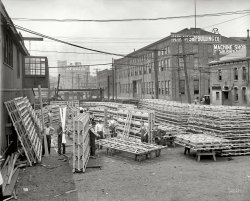
- Detroit: 1929
- Detroit, 1929. "Skyline and boats on the Detroit River as seen from Windsor, Ontario." Gelatin silver print, Library of ... size.
Good Times My great-uncle and aunt moved to Detroit in 1939 to run a Lendzion's 5 and 10 cent store in Hamtramck. They ... Posted by Dave - 11/11/2020 - 12:52pm -
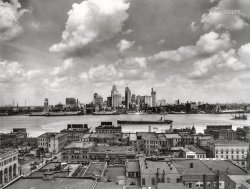
- Detroit River Tunnel: 1910
- The Detroit River circa 1910. "Michigan Central R.R. tunnel -- sinking the last ... contractors." 6½ x 8½ inch dry plate glass negative, Detroit Publishing Company. View full size.
Boys at lower right So ... of the photo for me.
(The Gallery, Boats & Bridges, Detroit Photos, DPC, Railroads) ... Posted by Dave - 08/09/2022 - 10:26pm -
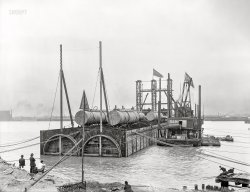
- Detroit Grand Circus Park, approx 1920
- ... of the Statler Hotel I was able to match the image to Detroit's Grand Circus Park. The next guess is the date. Possibly about ... Posted by bhappel - 09/21/2009 - 5:04am -
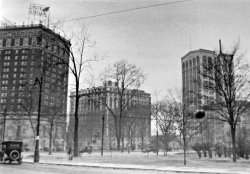
- Suburban Cowboy: 1963
- ... kind of life on a street like this in the early 1950s in Detroit as hard as that is to believe.
You want sunshine -- on a cloudy ... Posted by tterrace - 03/03/2023 - 12:57am -
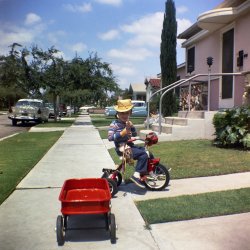
- Detroit Publishing: The Sequel
- Detroit, Michigan, circa 1902. "Detroit Photographic Company, southeast view." Our second look at the home of ... creating an over-obvious color job?
Postcards Was Detroit Publishing a competitor or as large a producer of postcards as the Curt ... Posted by Dave - 08/13/2014 - 2:49pm -
![Detroit Publishing: The Sequel Detroit, Michigan, circa 1902. "Detroit Photographic Company, southeast view." Our second look at the home of the Photochrom-process postcard. View full size.
Ripe for colorizationWith all the false-color postcards they turned out, someone should do some retro-justice to this plate. Any takers for creating an over-obvious color job?
PostcardsWas Detroit Publishing a competitor or as large a producer of postcards as the Curt Teich co. in Chicago?
[At its peak in the early part of the century, Detroit Publishing was selling around 7 million postcards and prints a year. - Dave]
(The Gallery, Detroit Photos, DPC)](https://www.shorpy.com/files/images/4a20860a.thumbnail.jpg)
- Nashua: 1908
- ... and Fletcher's Optical Parlors. 8x10 inch glass negative, Detroit Publishing Company. View full size.
1908 and 2017
... Posted by Dave - 10/20/2023 - 3:43pm -
![Nashua: 1908 1908. "Main Street -- Nashua, New Hampshire." At right, offices of the Nashua Telegraph and Fletcher's Optical Parlors. 8x10 inch glass negative, Detroit Publishing Company. View full size.
1908 and 2017
PigeonsJust try to tell me pigeons aren't trash birds!
Safe spaceMaybe you heard this already but WalletHub just named Nashua, New Hampshire, the safest city in America. The other nine in the top ten are Columbia, Maryland; South Burlington, Vermont; Gilbert, Arizona; Warwick, Rhode Island; Portland, Maine; Casper, Wyoming; Yonkers, New York; Burlington, Vermont; and Scottsdale, Arizona.
According to the same study, South Burlington, Vermont (the third safest city), "also tied with Cleveland and Cincinnati, Salem, Oregon, Washington, D.C. and Seattle for the most hate crimes per capita." Uh oh. Maybe move to Burlington, Vermont -- less than three miles away and coming in at ninth on the safest city list.
Or just stay put and take your chances.
CLOUDS!I don't know if it was luck or some type of different exposure process, but it's rare to see a sky with clouds in these old photos. The cameras couldn't pick up the subtle shades and usually the skies appear completely white even though at the time they may have been overcast or partly cloudy.
Because now you can bank onlineWorking left-to-right:
JennyPennifer's comment caused me to pay special attention to the police officer walking his beat, just to the left of the wagon parked at the curb. He's dressed like a London Bobby.
The four-story building with the curved front is, regrettably, gone. This likely happened when Main Street was straightened, and a newer bridge was built across the Nashua River. The Romanesque church at the end of the street is on the other side of the river.
The building at right, which became a bank in jrpollo's update, is now luxury condos, called The Mint. Not to criticize too much, but my first efficiency apartment had more kitchen space. I guess the residents are expected to eat out. A number of nearby restaurants have expanded their al fresco option to include both the sidewalk and the parallel parking spaces in front of their restaurant.
Straight and trueI lived in Nashua for 12 wonderful years and lived in the North End right off of Concord. This image did raise a question about the curved building a block from the river crossing. Any straightening alluded to earlier would have taken place much earlier in the 19th century...
The Sanborn Insurance maps of 1912 indicate that Main Street and the bridge were already where they are today. But the curved building, identified as the Howard Block gracefully curved to widen the main street from the width of the bridge (I am guessing). Main Street really is three lanes wide in each direction... feels like an avenue in Manhattan. I am also grateful that the Library of Congress has these Sanborn maps...! Terrific detail about buildings and their particular use.
Here is the link to that image: https://www.loc.gov/resource/g3744nm.g3744nm_g053631912/?sp=32&r=0.517,0...
Different process = CLOUDS!Eary photographic processes were primarily sensitive to only blue light. Numerous newer processes throughout the late 19th century added increases sensitivity into the greens and yellows resulting in what we now call orthochromatic materials.
It wasn't until around 1906 that a truly panchromatic emulsion with full sensitivity to red was developed. This took several decades to become dominant. It wasn't until the panchromatic films and plates became available that we begin to see photos that can render skies anything other than nearly blank white.
Orthochromatic materials remained in use for quite a while largely because you could develop them under a red safelight. Panchromatic materials required total darkness.
[Here and here, some clouds from 1864! - Dave]
Light grey/white clouds against a blue sky require a panchromatic emulsion, otherwise the clouds and sky reproduce nearly the same light grey. Only when the clouds are all grey and dark grey (think: storm clouds) will they reproduce on earlier orthchromatic or pure blue sensitive emulsions.
Tea TimeThe Grand Union Tea Company delivery wagon in the Nashua photo made me curious. My local New Hampshire grocery store used to be a Grand Union. I found a brief history of the company here:
https://oldmainartifacts.wordpress.com/2013/10/07/grand-union-tea-compan...
(The Gallery, DPC, Small Towns, Stores & Markets)](https://www.shorpy.com/files/images/SHORPY-4a22639a.thumbnail.jpg)
- Skinny Dippers: 1910
- Detroit, Michigan, circa 1910. "News Tribune newsboys' plunge bath." Someone make these kids a sandwich. Detroit Publishing glass negative. View full size.
There's one in ... a tiny pool there. But hey! better than nothing eh?
Detroit Athletic Club From an article on the Detroit Athletic Club in the ... Posted by Dave - 08/14/2012 - 4:58pm -
![Skinny Dippers: 1910 Detroit, Michigan, circa 1910. "News Tribune newsboys' plunge bath." Someone make these kids a sandwich. Detroit Publishing glass negative. View full size.
There's one in every crowdToday was plaid day. Didn't you get the memo?
What's the rule?Don't eat a month before swimming, or don't swim for a month after eating.
Surprise Swimmer!If you look closely, you'll see an African-American boy in the water on his back swimming. WOW! That seems unheard of for the time.
[That's no boy. - Dave]
PB&Js coming right up!Some things never change, and one of those is preteen boys! They look the same and act the same as my sons and the dozens of little boys who have been here to play with them over the last 20 years. I wish I had a dime for every PB&J I have made!
Those diaper things they are wearing are kind of interesting, aren't they?
Interesting photoIs this a way that the newspaper had to retain the kids to work for them? sort of like perk?
That is also a tiny pool there. But hey! better than nothing eh?
Detroit Athletic ClubFrom an article on the Detroit Athletic Club in the December 1888 issue of "Outing":
The bath-room caused much marvel in these parts. It is 30 by 16 feet in size. The centre of the marble-paved floor is occupied by the plunge-bath, 20 feet long and 12 feet wide. Its sides are lined with white enameled bricks, and a constant flow of water is secured from the city service-pipes.
Swim timeat Neverland Ranch!
Hoot Mon!Which Scottish clan are these laddies from?
CoverageIf my experience in boys parochial school and the Y many years ago is any guide, the bathing attire might be only for the photo. Normally we did without.
Not Too SkinnyIt is funny reading all of the comments about how skinny these boys are. In truth, this was normal and it becomes plain to see what an overweight nation we've become. Many old images posted from the period show everyday people and most are slim in our eyes when in fact this was considered normal.
The trunks have drawstrings on the side a la "one size fits all," and it seems that is true! Even though they look strange.
All Arms and LegsI remember when I was all arms and legs. That was in the late 1960's. Mother would tell us to go outside and play and never had to suggest it twice.
I worry when I see today's kids brought up on video games and very little other physical activity.
Pool party!I don't think I've ever seen a picture with so many kids smiling and having fun on Shorpy! They usually look so serious.
Birthday-suitedWhile a junior high student circa 1955, all of us boys would swim sans swimsuits in our public school's indoor pool, perhaps 60 of us during the one hour period. Naturally, we all wondered if our female counterparts did the same during their own sessions in the pool!
My inner 5th grader is all agiggle.The newsletter for the "Detroit Athletic Club" (where women may not have been allowed) was called "Outing?" I am not saying a word, but my inner 5th grader finds that extremely funny!
Hams, Divers, and HooligansI really love this picture. It has an incredible timeless quality to it-- just energetic little boys having a great time. Sans period clothing (I guess the trunks are distinctive) and distinctive early-19th century hairstyles, you can really see this happening at any time. As opposed to the many serious, posed, portraits on this site, there are so many characters evident in this shot. I love the grinning ham in the middle of the pool, and the kid in the middle/back of the pool waving at the camera! The lone, overwhelmed adult probably telling the kids not to dive, and the kid in the left foreground making an exaggerated diving motion and mischievous smile either preparing to disobey or pretend that he is going to disobey.
Just another great shot on Shorpy.
ObservationsOne adult is in the pool. One adult is trying to control the playful boys, and a third adult is hiding from the camera, in the alcove at left.
And none of the boys have shirts on, or the long wool pants you would see bathers at a beach wearing. Instead they all have strange plaid drawstring diaper-like trunks (except the fellow at the far left).
Are they not wearing the full bathing suits because they are in a pool rather than outdoors? Or because they are all children? Or because they are all males? Or maybe all three reasons.
If you said this picture was taken in 1970 instead of 1910, nobody would know the difference. That isn't true of beach photos from the same time.
Here's The Real SkinnyI notice that the only adult in this picture seems to be giving orders, but only the biggest boy's eyes are on him.
A long time ago at the YOh WOW! It is hard to believe that this photo is that old. But if it is, then all those kids are long dead! I went to the YMCA for swimming lessons. But we swam naked. The pool was the same depth throughout. Girls were at one end of the pool and us boys at the other end. The only people that wore swim clothes were the teachers.
Then after the lesson all of us kids could splash around for about 10 minutes. No wet swim shorts or wet towel to have to deal with.
I was about 11 or 12. Most of us were the same age. They was only one or two kids that were starting to develop "down there." Maybe some of the girls were the same. But you could only see from the neck up. There was nothing to see. The way you knew if it was a girl is that they wore swim caps to keep their hair.
Those were the days. Would I go back to them. NO!! Why? Because I grew up with migraine headaches. I would have 3 or 4 headaches a week. sometimes I would think that I had two of them at the same time.
My parents told me that it was all in my head. Well they were right. I had to endure them, but sometimes at school I would run outside and puke in the shrubs.
(The Gallery, Detroit Photos, DPC, Kids, Swimming)](https://www.shorpy.com/files/images/4a20121a.thumbnail.jpg)
- Detroit Opera House: 1900
- ... section of a four-part panorama whose center includes the Detroit City Hall view posted yesterday. Photo by Lycurgus S. Glover, Detroit Publishing Co. View full size.
Bicycles!!! I'm impressed by ... Posted by Dave - 08/14/2012 - 12:33pm -
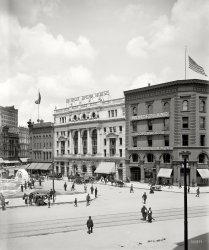
- Whooooosh: 1902
- ... winning five-miles event in 6:1 3-5, Grosse Pointe track, Detroit." 8x10 inch glass negative, Detroit Photographic Co. View full size.
What the heck is "6:1 ... Posted by Dave - 08/25/2023 - 5:59pm -
![Whooooosh: 1902 October 24, 1902. "H.S. Harkness in his Mercedes-Simplex, winning five-miles event in 6:1 3-5, Grosse Pointe track, Detroit." 8x10 inch glass negative, Detroit Photographic Co. View full size.
What the heck is "6:1 3-5"?Is that some kind of time recording from yesteryear, or is it perhaps a biblical reference from even more yesteryears?
[361.6 seconds -- 6:01 and 3/5. - Dave]
Speedy!If I read that time correctly, Harkness averaged 48.19 MPH
49mphThat's right around an average of 49mph. 5 miles at 6 min 13.5 seconds.
Or is it 6 min 1 3/5 seconds? Either way, close to 49mph.
Almost Flying... and within a year and a couple of months, powered flight would be achieved.
Whenever I feel times are changing too quickly, I think back to if I were my current age a century-and-a-quarter ago. Getting past congratulating myself for making it to the ripe old age of 63, I would be utterly appalled by the spread of internal combustion engines, shattering the air with their noise and spewing smoke, scaring the horses, and breaking all the rules of the road!
Well, I'm pretty much still in that state of mind. So maybe not everything changes so quickly!
H.S. HarknessHarry Stephen Harkness, heir to a portion of the Standard Oil fortune, was a noted automobile racer and aviator. He cheated death in a 1910 airplane crash but was not able to buy his way out of the Spanish Flu epidemic. He died in 1919 at age 38.
ConsensusSome scientists of note back then warned of exceeding 60 miles per hour, postulating that a human would face a lack of oxygen and pass out at the controls.
They were wrong.
Not in Grosse Pointe AnymoreHorse racing was a very popular pastime in Detroit at the turn of the last century and two horse racing tracks were built on the south side of E. Jefferson Avenue. One was called the Detroit Driving Club, where this image was taken. It was located at Algonquin Street and was designed by Mortimer Smith. Farther east out Jefferson Avenue at Marlborough Street was the Jockey Club. Both were in the Fairview Village area of Grosse Pointe Township. The Ford-Winton Race and the 1904 Thousand-Mile Packard Endurance Run took place at the Detroit Driving Club.
It wasn’t until 1907 that this entire area was annexed by the City of Detroit and the names Fairview and Grosse Pointe Township became lost over the passage of time.
More here: https://wikimapia.org/33799129/Detroit-Driving-Club
(The Gallery, Cars, Trucks, Buses, Detroit Photos, DPC, Sports)](https://www.shorpy.com/files/images/SHORPY-4a09791a.thumbnail.jpg)
- Easy Payments: 1906
- Detroit, Michigan, circa 1906. "Askin & Marine credit parlors." 8x10 inch dry plate glass negative, Detroit Publishing Company. View full size.
Gotta Give 'Em Credit ... the movies."
Sarah Farly According to the 1906 Detroit city directory , Sarah J. Farly (widow of Stephen M. Farly) was the ... Posted by Dave - 08/13/2012 - 9:14pm -
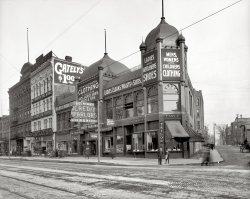
- Country Kitchen: 1942
- ... and the juicer. Ahhh, those were the days.
Made in Detroit -- "Tasty-Krisp Popkorn" ... just to the left of Sanka. ... Krisp Products was located at 11166 Grand River Avenue in Detroit. Now an empty lot in a much-decayed neighborhood, but in the 1940s it ... Posted by Dave - 01/19/2023 - 11:43am -
![Country Kitchen: 1942 July 1942. "Birmingham, Michigan (vicinity). Kitchen in a country house." 4x5 inch acetate negative by Arthur Siegel for the Farm Security Administration. View full size.
Eleven Years Later ... ... I finally see the rest of the kitchen. I clicked on "Kodachrome treatment" and discovered I made a comment on 01/01/2012.
[There's even a third pic! Check back in 2034. But seriously, the negative for this particular photo didn't get scanned until 2022. - Dave]
Drink Sanka Coffee and Sleep!My grandma use to drink Sanka. I remember seeing the jar in her kitchen when we'd visit. I also remember seeing Grandma's weed she kept in a big jar, between the Sanka and the juicer. Ahhh, those were the days.
Made in Detroit -- "Tasty-Krisp Popkorn"... just to the left of Sanka. Popcorn was the go-to snack in those days. Tasty Krisp Products was located at 11166 Grand River Avenue in Detroit. Now an empty lot in a much-decayed neighborhood, but in the 1940s it was growing and prospering.
Cold QuestionHave to wonder what the jar of cold cream is doing on the kitchen counter. With 6 sisters I sure saw a lot of that product in my youth, but always in the bathroom. Perhaps there's a culinary use I'm not aware of?
[In the kitchen, a cold cream jar is not necessarily a jar of cold cream. - Dave]
The MirolarmThe clock on the shelf is a Telechron Model 7F77, or "Mirolarm". Made between 1932 and 1938, it was Telechron's first "buzzer" alarm clock and would have been rose colored glass with a mirrored background.
[Not to be confused with "Mirro" brand kitchen timers, or Joan Miró. - Dave]
Grandma's weed?My first thought was: What’s a jar of nails doing on the kitchen counter?
From the breadbox libraryCharles Gundel's "Hungarian Cookery Book" had its first printing in 1934 and is still available 45 printings later, and Gundel's is a world-class restaurant in Budapest still in business today. If one enjoys Hungarian food, this cookbook with its delectable offerings is sure to throw one off their January weight loss diet.
Sone things never change (much)The bottle near the middle of the top shelf, in the paper wrapper, is clearly Angostura bitters. The labeling is amazingly similar to the one on my shelf, 80-plus years later.
And my tin of Colman's Mustard is still more like this one than it is different.
Bitters with the sweetThere's a bottle of Angostura bitters on that top shelf next to what might be maple syrup.
UtensilsArthur Siegel also gave this kitchen the Kodachrome treatment --
Maybe not weed --Oregano?
Well-wiredAny decorator magazine today would publish this kitchen with the word "whimsical" somewhere in there, but they would either studiously ignore the exposed electrical conduit, or comment on its "industrial" aesthetic. This is certainly an unusual abundance of electrical outlets for a kitchen of this period, and no doubt added at the owner's discretion to serve their abundance of kitchen gadgets. (How many people had an electric orange juicer in 1942?) Notice the light fixture above, with the original wiring concealed in the walls.
In 1940, the National Electrical Code added a requirement for a dedicated 20 amp circuit for kitchen appliances, something that had been recommended as a best practice for a couple of decades. My sense is that this rule was little-enforced, as wartime materials shortages soon prevented compliance. But here's the original concept, illustrated in an official publication of the 1893 World's Columbian Exposition.
Edit: I mistakenly typed "conduit," though this is clearly the first-generation iteration (1928-ca1950) of non-metallic sheathed cable, popularly known by the trade name Romex.
Brought to You By --Shorpy should get ad fees for product placement:
Kroger’s
Colman’s
Durkee’s
Jell-o
Sunkist
Sanka
Mary Scott Rowland
Grandma's laboratory Perfect meals
(The Gallery, Arthur Siegel, Kitchens etc.)](https://www.shorpy.com/files/images/SHORPY-8c28548a.thumbnail.jpg)
- Detroit Edison: 1910
- Circa 1910. "Edison Electric plant (Detroit Edison Company), Detroit, Michigan." 8x10 inch dry plate glass negative, Detroit Publishing Company. View full size.
Delray Power Station? I ... Posted by Dave - 11/04/2014 - 9:39am -
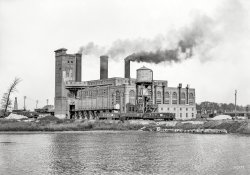
- What Goes Around: 1912
- The year is 1912 and the place is Detroit. What's going on here? View full size.
UPDATE: Many people ... caption: "April 4, 1912. Foundation for gas holder, Detroit City Gas Company."
Happy Thanksgiving To Dave and all of the ... of the base of a gas storage tank, probably at Detroit.
I dunno, unless it's some kind of early 20th-Century ... Posted by Dave - 08/09/2012 - 10:50pm -
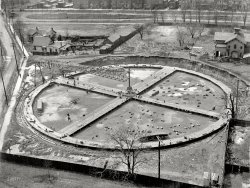
- Detroit Deli: 1912
- Detroit, Michigan, circa 1912. " Edelweiss Cafe , delicatessen room." 8x10 inch dry plate glass negative, Detroit Publishing Company. View full size.
Buy one new today ... motor. Amazing piece of engineering.
(The Gallery, Detroit Photos, DPC, Stores & Markets) ... Posted by Dave - 07/04/2011 - 2:14pm -
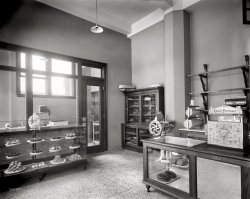
- Bizarro Detroit: 1904
- ... Fast-forward one year: The Detroit hard at work .
Ecorse, Michigan, 1904. "Great Lake Engineering Works. Steamer Detroit , Michigan Central Transfer, stern quarter." Or would that be ... Posted by Dave - 05/04/2017 - 9:14am -
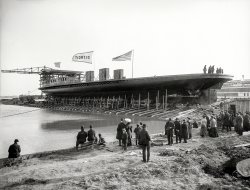
- Detroit Publishing: 1910
- Detroit, Michigan, circa 1910. "Detroit Publishing Company, east front." The mothership for much of the ... photography seen here. 8x10 inch dry plate glass negative, Detroit Publishing Company. View full size.
Home Sweet Home How nice ... Posted by Dave - 08/21/2012 - 12:38pm -
